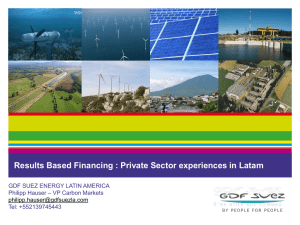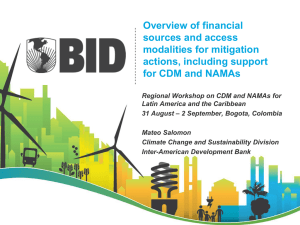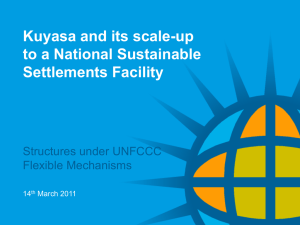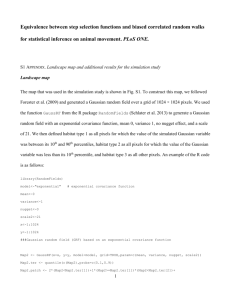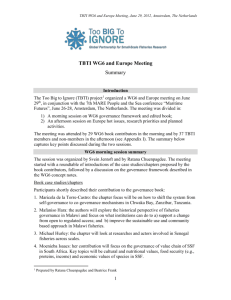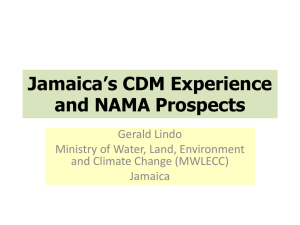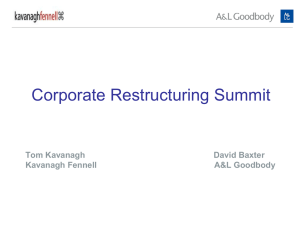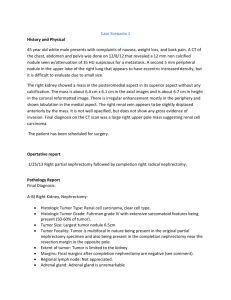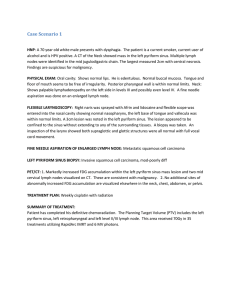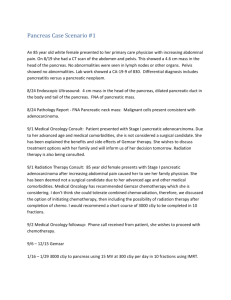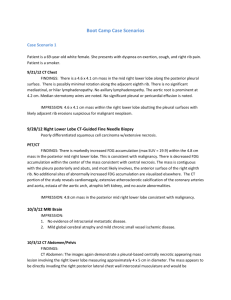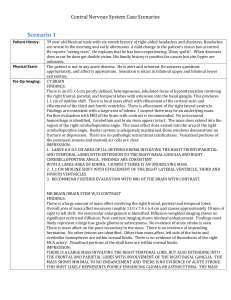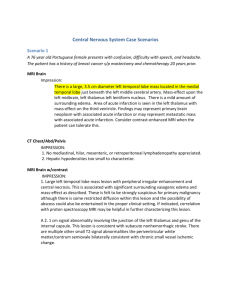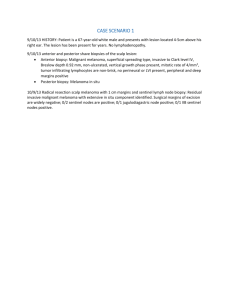the development bank of southern africa
advertisement
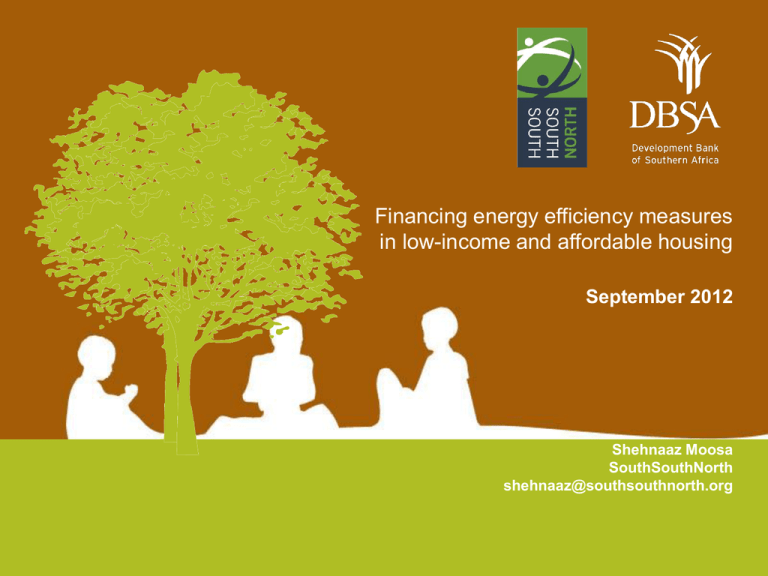
Financing energy efficiency measures in low-income and affordable housing September 2012 Shehnaaz Moosa SouthSouthNorth shehnaaz@southsouthnorth.org Presentation Structure • • • • • Sustainable Settlements Facility Housing Landscape Financing Landscape Costing the SSF NAMA Way forward • NAMA 2 Sustainable Settlements Facility (SSF) • The SSF is envisaged as a large scale public programme which will establish all future subsidised and gap housing in South Africa as low carbon, removing significant future demand from the coal dominated South African grid. • By accessing international climate change finance, together with potential matching domestic energy subsidy finance through a dedicated Facility operating outside the DHS structures, the SSF will enable this policy to be enforced. The co-benefits including poverty alleviation and reduction in electricity demand are substantial. 3 The Sustainable Settlements Facility (SSF) NAMA • The SSF emerged as a concept from the lessons of the Kuyasa CDM demonstration project addressing methodological design issues in terms of carbon credits • The SSF has the support of National Government as a NAMA and is identified in the National Climate Change Response Strategy as a flagship project • The SSF is envisaged as a critical element of a wider climate finance strategy 4 Context: Housing Landscape • South Africa’s current housing plan (BNG, 2004) is taking up the thrust of UN’s MDG target 11 • Eliminate all shack housing in the country • Replacement of all shacks by 2014 • Current housing delivery focuses on quantity • Opportunity to improve the quality of the houses especially on the aspect of energy efficiency • Addendum XA10400 to the National Building Regulations • Solar water heater • Insulated ceiling • Energy efficient low cost housing is an integral part of sustainable development • Numerous housing solutions are possible within this spectrum 5 Housing Landscape (cont.) Year Housing Backlog 1996 1.5 million 2001 1.8 million 2011 2.1 million Source: DoH, 1994 and NDHS, 2011 6 Background: Kuyasa CDM demonstration project • Kuyasa CDM (http://www.kuyasacdm.co.za/) • 2309 low-income houses in Khayelitsha with a SWH, insulated ceilings and energy efficient lighting • 2.85 tones of carbon per household per annum saved • Significant social and economic benefits • Access to hot water • Increase in disposable income • Local job creation 7 Summary: SSF as a NAMA • Existing demonstration projects: • Kuyasa CDM Pilot Project (http://www.kuyasacdm.co.za/) • Quantify emissions reductions • 168 million tCO2 for a 28 year period • Assess barriers to implementation • Financial • Technology • Capacity • Assess scale up potential • Housing backlog therefore high potential 8 Financing Landscape • Under the current subsidy framework: • Cost approximately US$ 37 billion to clear a backlog of 2.2 million units (approximately US$ 17,000 per unit) • Assuming a delivery rate of 250,000 housing units per year, the annual budgetary implication is approximately US$ 4.25 billion • Beyond the fiscal capacity of the South African State • Excludes any additions • Solar water heaters • Energy efficiency interventions • A gap exists between the need for energy efficient low-income housing and the capital available to pay for it. 9 Financing Landscape • National Department of Human Settlements low income housing delivery programme • Opportunity to improve the quality of people’s lives • Improved housing quality • Energy access • Reducing future carbon emissions • Integration of South African Government initiatives: • DTI • Inclusion of solar water heaters and energy efficiency • DEA • National programme to bring sustainable resource use criteria into the design of the settlement projects and subsidized houses across the country. With special reference to: • Housing densities, orientation of the buildings, roof overhangs and insulation, installation of 1000 000 solar water heaters by 2014, and sustainable use of water and waste resources. • Green Economy Accord promoting the use of clean stoves • DEA and DBSA • Green economy summit • Energy efficiency 10 The SSF as a NAMA Current outlook for the SSF NAMA: Initial ODA to scope and prepare with the potential to be a supported NAMA with a contribution from local Green Funds. Official Development Assistance Bilateral Multilateral Supported NAMAs Green Climate Fund Registry Unilateral NAMAs Market Based Mechanisms Domestic Financing Carbon financing 11 Costing: No Carbon, including MRV 80 1600 70 1400 60 1200 50 1000 40 800 30 600 20 400 10 200 0 0 1 2 3 4 5 6 7 8 9 10 11 Number of houses 12 13 14 Cost (Rands) 15 16 17 18 19 20 21 196M US$ 171M US$ Cost (Millions of South African Rand) Housing units (in Thousands) Cost for BNG Houses with SWH and Energy Efficiency Interventions 146M US$ 122M US$ 98M US$ 73M US$ 48M US$ 24M US$ 12 Cost vs. subsidy for New Build with energy efficiency & solar water heater 60000 6108 US$ 50000 4886 US$ 3664 US$ 2443 US$ 1221 US$ Cost in South African Rand 7329 US$ 40000 Cost 30000 Subsidy Income Shortfall 20000 10000 13 0 EE Interventions SWH Top Structure x 10000 Cashflow with carbon revenue 180000 Cashflow as a function of carbon revenue 160000 140000 120000 100000 80000 Carbon = 12 Euros 60000 Carbon - 6 Euros Carbon - 2.4 Euros 40000 20000 0 1 2 3 4 5 6 7 8 9 10 11 12 13 14 15 16 17 18 19 20 21 -20000 Note: Current (Sept. 2012) market prices for CO2e credits are in the approximate €2/US$2.5 range. 14 Sustainable Settlements Facility: Timeline Date Progress 2006 Analysis and interrogation of carbon methodological work at Kuyasa funded by REEEP 2007-2010 Extensive methodological design work financed by DBSA, DANIDA, South African Export Development Fund and Energy Development Corporation 2010-2012 Design phase of programme delivery funded by KfW integrating carbon methodological designs, public and private sources 2013 Target date or SSF to be operationalized and accessible 15
